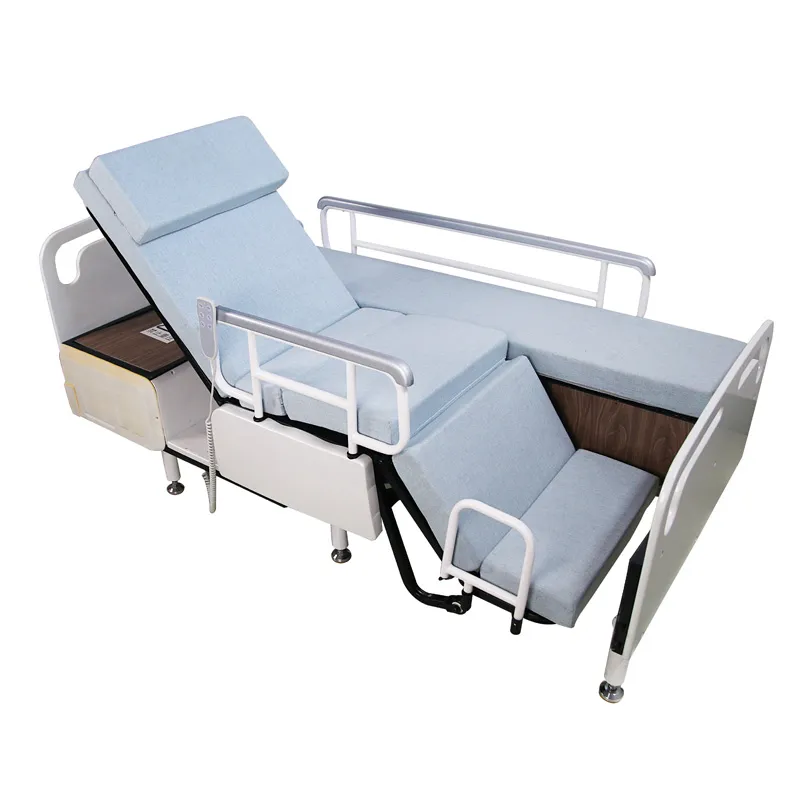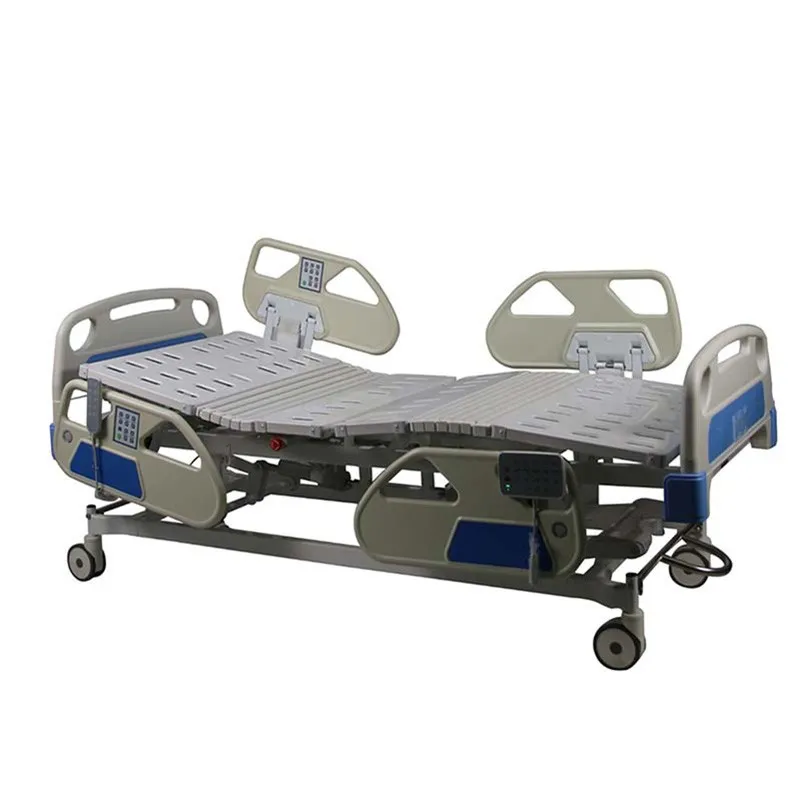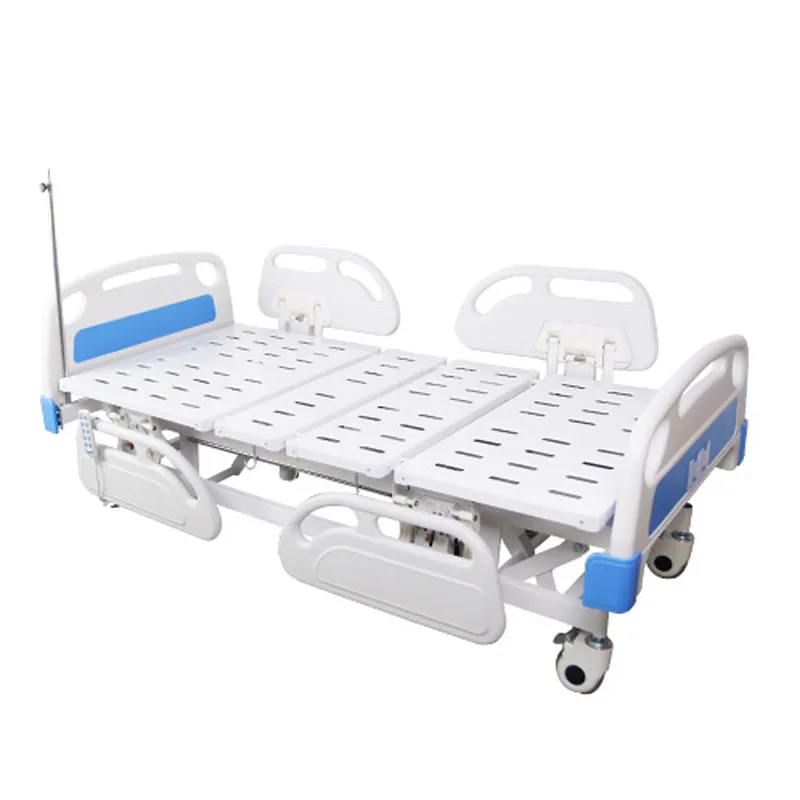Hospital power outages, home power outages, emergency operating room resuscitations—whenever electricity, a fundamental resource, is limited, the ability of a motor-driven electric hospital bed to provide emergency care and safely lower the patient becomes a matter of life and death and nursing safety.
"Do electric hospital beds have backup batteries? How can the bed be lowered in the absence of power?" This is not only a concern for nursing staff and families, but also a crucial technical detail that must be clarified in hospital equipment management and procurement.
In conclusion:
Most modern medical electric hospital beds are indeed designed with some form of backup power supply or emergency release device, but their form and capabilities vary greatly: from small disposable batteries in the controller (such as a 9V battery for a one-time "lowering/reset" operation) to built-in rechargeable battery packs (supporting multiple adjustments), to older models that have no batteries at all and rely on a hand crank.
If the electric backup power supply is unavailable or the bed itself has no battery, there are two common emergency approaches:
1) Use the manufacturer-provided emergency crank/handle or mechanical release device;
2) In the event of a short-term power outage, use a temporary external power source (hospital UPS/backup generator or portable home power supply) to power the bed. The power supply plan must comply with safety regulations.
Backup batteries typically only guarantee limited functionality. Many backup power supplies only support the most critical actions such as lowering the bed/one-button lying down/CPR, and cannot maintain all advanced functions (such as maximum air mattress inflation). Therefore, the "what the backup battery can do" should be clearly defined during procurement, installation, and routine inspections.

Why are batteries/emergency devices crucial for electric hospital beds?
With the increasing electrification rate in hospital wards, electric hospital beds are extending from general wards to ICUs, postoperative recovery rooms, and long-term care wards. Electric hospital beds use motors to adjust bed height, backrest, leg rests, overall tilt, and CPR return, greatly improving nursing efficiency and patient comfort.
However, in the event of a power outage, if the bed cannot quickly return to a safe position, the following risks may arise: inability to promptly perform CPR in a supine position, inability to adjust the position leading to complications, obstruction of patient transport, and increased workload for medical staff.
What forms of backup power does an electric hospital bed take?
1. Controller with built-in small-capacity dry cell battery (e.g., 9V)
Purpose: Typically used for basic remote control recognition and to allow for one-time or limited positional movements (e.g., lowering the backrest, flattening the bed) when no external power is available. Some home electric hospital beds or elderly care beds use this solution to save costs.
2. Built-in rechargeable battery module (sealed lead-acid or lithium battery)
Purpose: Supports multiple adjustments and ensures that several key actions can be completed during a short power outage (bed height, backrest, leg rest, and CPR return to position). High-end ICU/critical care beds and some hospital-grade electric hospital beds often come standard with rechargeable backup batteries or offer them as an optional accessory.
3. External UPS/Backup Generator/Portable Energy Storage Power Supply (Commonly Used in Home Scenarios)
Purpose: In the event of a power outage at home or in a facility, an external UPS (Uninterruptible Power Supply) or fuel/gasoline generator can provide power to the electric hospital bed. In recent years, community and home users have also begun using portable high-capacity energy storage devices (such as EcoFlow, Jackery, etc.) to provide emergency power for hospital beds or air mattresses. User forums and nursing communities have numerous practical experiences shared on this topic.
4. Models without Batteries, Equipped with a "Manual Emergency Crank" or "Mechanical Release" Design
Purpose: Some semi-electric beds or older electric hospital beds use a hand crank or manual release mechanism as an emergency solution to reduce costs or simplify the structure. Manufacturer manuals clearly instruct on how to manually adjust and return the bed using the handle or crank. User manuals from manufacturers such as Dayang Medical and Hill-Rom describe the use of the emergency crank.

What can a backup battery for an electric hospital bed do?
• Capabilities: Most built-in batteries or controller batteries are designed to "ensure critical actions can be performed during short power outages"—such as lowering the backrest, quickly lowering the bed, performing CPR, or turning the patient to a safe position. High-end built-in batteries can perform multiple actions and maintain full electric function for short periods.
• Limitations: Backup power is not "unlimited power." Many bed backup batteries do not support full functionality such as maximum inflation of the air mattress pump, multiple consecutive bed turns, or networked monitoring systems. For example, manufacturer documentation explicitly states that the automatic inflation function of some mattresses is limited when powered by batteries.
• Misconception: Some people believe that "an electric hospital bed with a backup battery is foolproof." This is not the case: backup batteries require maintenance (charge cycle testing, replacing batteries past their lifespan), are insufficient to replace a generator during prolonged power outages, and have significant performance differences between brands and models.
What to do when there is no power/backup battery is unavailable?
Below is a sequence of actions from "highest priority, most common" to "last resort." Before proceeding, please refer to the manufacturer's manual for your electric hospital bed (each bed has specific locations and procedures). The following procedures and safety tips are general guidelines; please refer to the manufacturer's instructions for specific details.
Preparation before operation (mandatory)
• Remain calm and assess the patient's condition: Confirm whether the patient's vital signs are stable and whether immediate CPR or emergency procedures are needed.
• Call technical support or head nurse/equipment maintenance personnel: If the hospital has an equipment maintenance team, request support immediately. Notify the on-call engineer or contact the bed supplier's customer service.
• Locate the bed manual and emergency tools: Most beds have an emergency crank or instruction manual in the footboard or bed frame; the remote control may have a 9V battery compartment on the back.
Step A: First try the backup power (if available)
Confirm the status and location of the backup battery: Locate the battery compartment on the bed or controller, connect it according to the manufacturer's instructions, and use the remote control or panel to execute the "lower/lie flat" command. Many manufacturers indicate in their documentation that "the backup battery can be used for one-button lying flat/CPR."
Step B: Using the Manual Emergency Crank or Mechanical Release (if the Bed is Equipped)
• Locate the Emergency Crank: Invacare, Hill-Rom, and other manuals indicate that the emergency crank is usually located in a storage compartment on the side of the bed, in the footboard, or in the control box. Insert the crank into the designated hole as instructed in the manual and rotate it clockwise/counterclockwise to slowly lower the bed height or backrest.
• Key Points: Maintain smooth rotation; avoid sudden, excessive force. If unsure of the location and orientation of the emergency crank, confirm with the manual or video before proceeding (manufacturers often provide instructional videos).
Step C: Using the CPR Return Function (if Available)
Most modern electric hospital beds have a CPR quick return or release handle: In uncontrollable situations, pressing the CPR return button or pulling the dedicated release handle will instantly flatten the backrest, facilitating chest compressions.
Step D: Attempt External Temporary Power Supply (to be performed only by qualified personnel or as directed by the manufacturer)
• Hospital Level: Activate the ward UPS or switch to the hospital's backup generator; have the engineering department connect and verify grounding and safety.
• Home/Community Level: A certified portable power storage unit (power station) or car inverter can be used for short-term power supply to allow the bed to move once or several times; however, always avoid using indoor fuel generators (risk of carbon monoxide poisoning), and ensure that cables, plugs, and the bed's power specifications are compatible.
Step E: Temporary Patient Management When Bed Cannot Be Lay
Maintain and reassure the patient's vital signs; support the patient in a comfortable position using pillows and side supports if possible.
Organize manual transfer or transfer using a stretcher/skateboard with the assistance of nurses and technicians, and move the bed or patient to an available or manually operated bed with power as soon as possible.
Record the incident, notify the clinical supervisor and equipment maintenance, and investigate the cause of the malfunction.
(The above operating procedures are based on manuals from multiple bed manufacturers and a summary of nursing engineering experience. Please refer to the respective instruction manual for the crank position, handle direction, and operating torque for specific bed models.)

How does Dayang Medical ensure competitive wholesale supply?
Dayang Medical operates two R&D and production bases in Foshan, China, giving us strong supply capacity and efficient manufacturing processes. This allows us to offer wholesale buyers competitive prices, reliable delivery, and stable stock. Our factory supports customized production, bulk order discounts, and promotions for international purchasing. As a leading China supplier, we provide professional wholesale services to meet the needs of global buyers.










